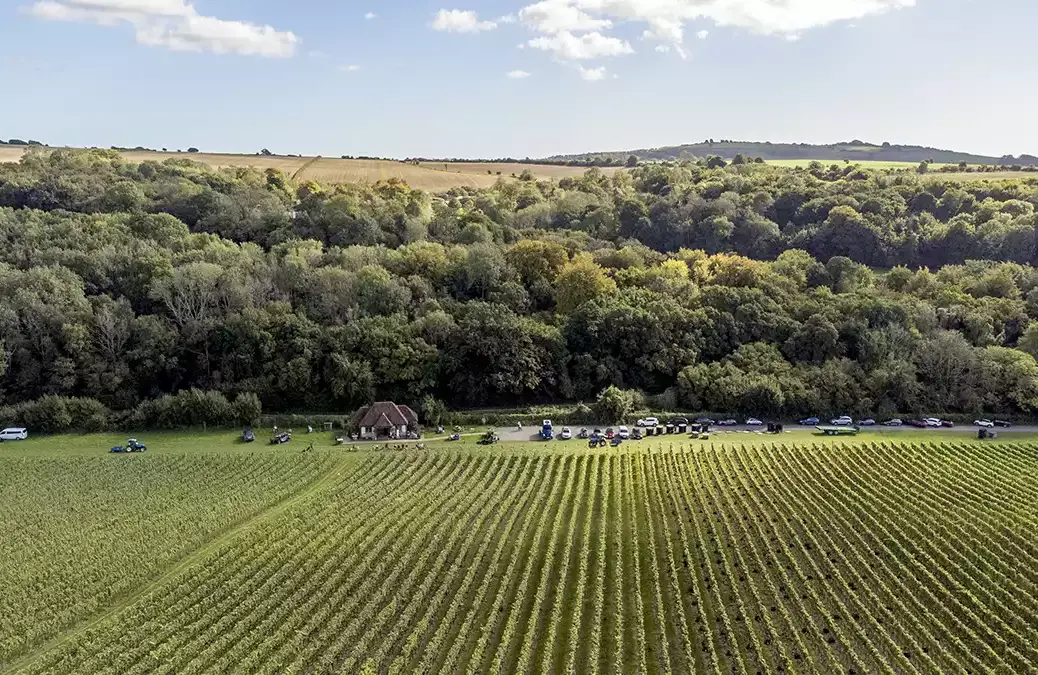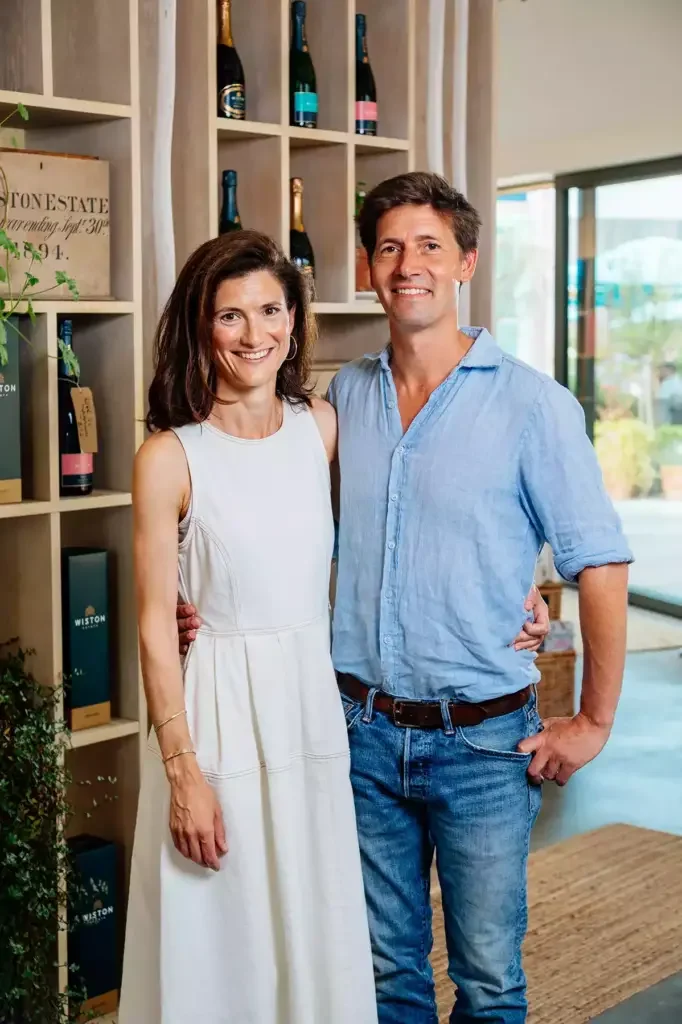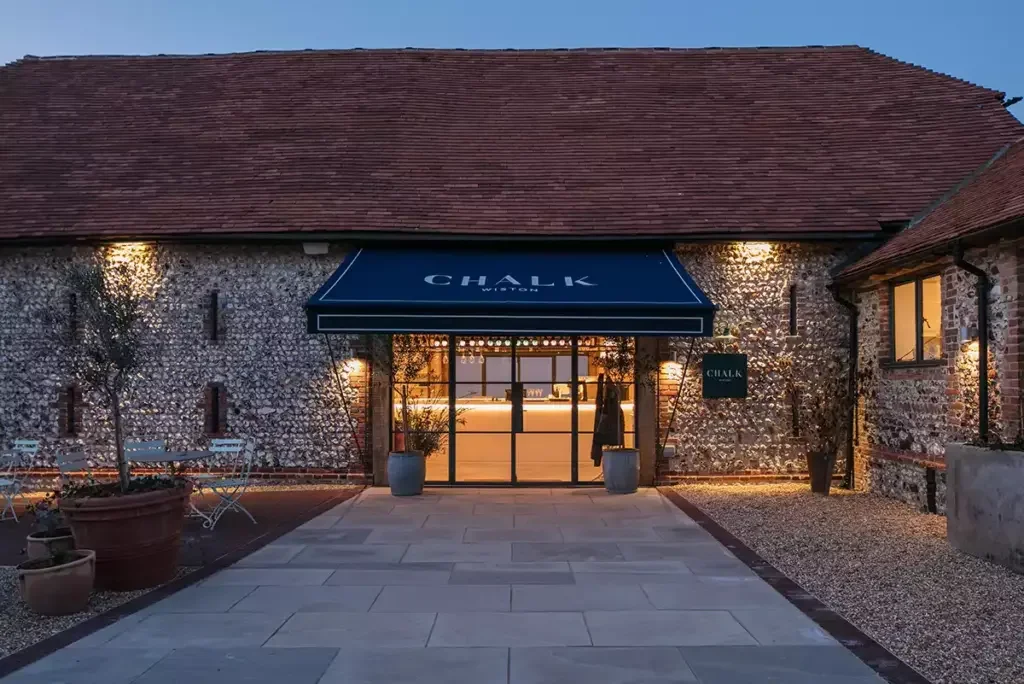
Margaret Rand visits a part of the South Downs famed (and nicknamed) for its warm climate, where the Goring family is making fine sparkling wines of tension and generosity on their sustainably managed farm at Wiston Estate.
It used to be called the banana belt, this stretch of the South Downs where so many top wine estates are now found. It was warm, and the crop grown there was good—though that was long before the crop was grapes for sparkling wine. Dermot Sugrue told me that, when he was winemaker at Wiston Estate. His own wine comes from the banana belt, and so does Wiston’s, from the southwest corner of a 6,000-acre (2,430ha) property owned by the Goring family. Wiston was mentioned in the Domesday Book. The banana belt, obviously, didn’t feature.
The vines, all on chalk, take up 37 acres (15ha). Another 1,000 acres (405ha) is woodland, 2,000 acres (810ha) are farmed by the estate, and the rest is tenanted. There’s also a couple of chalk pits, with some commercial quarrying, and a sandpit. Half the estate is on the Downs, half on the Weald, and it’s sufficiently high up to see the Isle of Wight on a clear day. The Chanctonbury Ring is on Wiston land, an Iron Age fort planted with beech trees in 1760 by Charles Goring, the trees hand-watered until they could manage on their own. The Downs may look bare and exposed now, but there have been people here for a very long time.
There is no more water on the Downs now than there was then. Wiston doesn’t irrigate, and when they planted some vines in spring 2022, they feared the young plants wouldn’t make it through the hot, dry summer that followed. But chalk is a remarkable thing, and they survived.
As has the estate, despite death duties that reduced it from 20,000 acres (8,093ha) to its present size and the leasing of Wiston House to the Foreign Office on, one might think, a not-very-favorable lease: The estate has responsibility for the exterior, which is, as we all know, usually the most expensive bit.
But let’s jump to 1972, which is when Harry Goring married Pip Broadbent. She was South African, but with an English father, brought up in Franschhoek, and she missed the warmth. In particular, she missed the vineyards, and she tried and tried to persuade Harry to plant vines. Tried and tried and tried. But these were the ’70s, which became the ’80s, and planting vines in England was eccentric. It certainly wasn’t economically viable. Instead, Wiston had a turkey farm, and cattle, sheep, and arable. Early visitors to the estate will remember the turkey shed; it was the functional, unglamorous space where Dermot Sugrue made those first vintages. Because of course Pip eventually got her wish. The first vines were planted in 2006. How did that happen?
It was not because of the persuasiveness of Pip’s business plan, because she didn’t have one. But she was persistent. And when, in 2005, Champagne houses came sniffing around to see if they might rent some land, things finally came together. The advice of Stephen Skelton was sought, and he walked the chalk hills with them. “He was invaluable,” says Kirsty Goring, daughter-in-law of Pip and Harry and married to Rick; they are the current generation at Wiston. “Stephen thought there were only 1,000 acres in England this favorable for vines,” she adds.
That original vineyard, Findon Park, was planted in 2006 and consisted of 16 acres (6.5ha) of Pinot Noir, Pinot Meunier, and Chardonnay. There have been three stages of planting since: Broadwood, which is Chardonnay only; North Farm Vineyard, which is Pinot Noir only; and North Farm Valley, which is half and half Chardonnay and Pinot Noir. The only Meunier is in the first planting. And it is Chardonnay that shines here; it sings in the wines and gives a particularly fine but firm structure. Yes, Chardonnay on chalk in England can be austere, and Wiston in its early days was very austere, even challengingly so. I remember the first time I tasted the wines; they were clearly good, but you would not have called them friendly.
What has made the difference, says Kirsty, is time and, in particular, the building-up of stocks of reserve wines. There is no problem with aging these wines—they need age, and they blossom with it. A good slug of reserve wines in the blend (they launched their first Non-Vintage in 2015, and the NV Blanc de Blancs has about 20 percent reserve wines) plus more time on the lees reveals depth and richness without any loss of purity. Wiston is on a roll.

True sustainability
Back then, however, it still felt pretty risky. Champagne grower Jean-Manuel Jacquinot became consultant to the embryo project, and he and Pip visited Nyetimber, another banana-belt site, and met its winemaker, who happened to be Sugrue. Sugrue is discreet about how the changeover happened, but soon afterward he was no longer winemaker at Nyetimber and was instead winemaker at Wiston.
But this was not a project with money to throw around. There was no winery and no plan for one. The cost of planting the vines had been covered by selling a dairy herd and equipment. But Dermot reckoned a winery could pay its way via contract winemaking, and a basic winery was put together in the old turkey shed. An old Coquard press was put in, secondhand barrels were sourced, and an array of tanks, all the different sizes necessitated by the contract-winemaking arm. As well as making Wiston, Dermot made his own wines there, from the 1.5 acres (0.6ha) of vines he rented near Storrington, and he made Digby, Jenkyn Place, and several others as well. Back in 2017, Dermot was making up to 20 different wines each year; in 2024, Wiston will bottle between 200,000 and 220,000 bottles for six contract clients, and 140,000 bottles of its own wines.
Also in 2006, just after the vines went in, Richard Goring and his wife Kirsty returned from Canada. Richard was the son and heir. Time for a flashback.
Kirsty and Rick had met at a church holiday camp when she was 14 and he was 16. He, she says, decided she was The One; they kept in touch and stayed in touch while he went to Edinburgh University and she to Oxford, to read history at Magdalen, where she first tasted Château d’Yquem—and liked it.
Her grandmother, however, considered her rather ineligible because of her lack of practical skills and suggested a cooking course. “A friend had done a course at Ballymaloe,” says Kirsty. “I thought maybe I could handle it.” Of course, she loved it; and Ballymaloe lists Wiston’s wines now. Post-Ballymaloe she worked in the charity sector, with a cooking business on the side, doing private parties. “I loved pairing wines.” She found that learning to taste came pretty easily. “I’ve always had a powerful sense of smell,” she says—to the extent that some of her brother’s teenage friends could be rather a trial. It’s a sense she inherited from her mother and has passed to her younger son: “A high-tensile ability,” she calls it.
She and Rick married when she was 24 and he 25, and they spent a year in London before going to Canada. They were WWOOFing; there’s an organization called Worldwide Opportunities on Organic Farms, which places people on farms for a couple of months at a time. They are there both to learn and to work—and to work hard. And when one placement is finished, they move on to another. The organic farm at Ballymaloe had set Kirsty on the organic path, and this was to be a year of learning and hard labor to take it further: “Most of our friends were partying in London,” says Kirsty. But they wanted to go somewhere where nobody knew who they were, where they could assimilate and learn the culture, and so they wanted to be able to speak the language. They chose Canada, and they chose the far west because the farmers there were pioneers: “They had gone west, and gone west again,” says Kirsty. They went to Vancouver Island, then Cortes, Hornby, Queen Charlotte Island—places from where the next stop is Alaska. They found people living off-grid, growing all their own food. “We saw that they were sustainable, not in a trendy way, but because they never knew when their next supplies would come. And they knew that in a crisis they would not be a priority. They had to be able to survive… Rick was more use than I was, because he had trained as a carpenter in London and had worked with architects on doing up London houses when people had more money to spend than they do now.”
She adds, “When we left London in 2004, there was no recycling in London. But here people were using things many times over. It was an education in how to live.”
Canada was supposed to be for a year but was 18 months in the end. “We thought, we don’t trust ourselves to put these sustainable ideas into practice if we go back to London.” And of course there was an expectation that Rick would take over the estate. So, to Wiston they went.
“Rick had grown up here with very few people around, and he went to London [in the first place] because there was no viable rural economy.” And so, it became their ambition to create “something sustainable in all aspects, including making the young feel that they could stay.” In Rick’s childhood, “the wheat went to the wheat market, the cattle went to the cattle market, and nothing went direct to the consumer, so there was no reason to bring anyone to the farm. It can be very isolating.” Bringing people in, creating a buzz so that people would want to stay in what is quite a remote spot, became part of the sustainability plan. “Our head forester Tom took the whole team out, and they said that they’d learned more in an hour and a half than they’d ever learned before.”

Remodeling and building
Rick didn’t take over Wiston straightaway. He had no formal training in land management, but he went to work on a neighboring estate in Angmering, working for David Pennell, who now runs Burghley Estates in Lincolnshire, and after that worked in every department at Wiston—forestry, property, commercial, you name it. Kirsty worked at Higgidy Pies, then a small start-up, doing product development and PR and marketing. Rick did a business growth course at Cranfield School of Management; he took over Wiston in 2011. He brought to it a passion for regenerative farming: “Chalk grassland is not far from peat in terms of being a carbon sink,” says Kirsty. They see part of their role as engaging with people to spread the word, so they do tours, they work with schools; and there is a cellar door. When they decided to have a cellar door, they also decided to have a restaurant. And the restaurant, at every wine estate you can think of, has to reflect the quality of the wine: Sandwiches and a scotch egg will not cut it. The result is Chalk, where the food is very, very good and—of course—seasonal and local.
Viticulture is sustainable and organic, but not certified—for pragmatic reasons. The winery has evolved, and a Bücher press and a Willmes press have joined the original enormous Coquard press. Buildings have been remodeled and updated, and in 2019 they added some new buildings; this year they plan to add more storage. Everything is as sustainable as possible: There are solar panels on the roof of the winery, and the bottle storage is insulated rather than chilled; cardboard is recycled, and Chalk can use old barrels for smoking.
As we’ve noted, the style of the wines has evolved. It has always borne Dermot’s thumbprint of purity, tension, and high acidity, but that is also the thumbprint of the land; at the very least, they evolved together. Most wines do the malo, and six years of lees aging and six months in bottle post-disgorgement is their ideal, at release. Pinot Noir adds heft. For the 2016 Cuvée (55 percent Pinot Noir), I wrote “dazzlingly dark”; that darkness, carried on the acidity of Chardonnay, feels both counterintuitive and compelling. The wines are powerful, saline, and serious—but they dance.
Dermot has now left to concentrate on his own expanded property, and the cellar is in the charge of Marcus Rayner-Ward, who arrived at Wiston in 2018 and had five years with Dermot; he says that it’s the land that dictates the style. Having arrived when he did, he didn’t know Wiston in its early austerity; the Wiston he knows is the Wiston of tension and generosity. One might infer that the style is unlikely to change under his watch.
Jacquinot still consults and comes twice a year to taste everything. “It’s like having the headmaster to visit,” says Kirsty. And financially, the winery seems to be in a good place. For years it was underpinned by the arable farm, but in 2020, says Kirsty, “it turned a corner” and is now washing its face. The first 16 acres cost £250,000 to plant, and the cost of planting the three other vineyards was the same. They spent £7 million on remodeling the winery, creating the cellar door, tasting room, and event space, building a parking lot, building four new commercial buildings at North Farm, and restoring the flint barns that now house Chalk. It’s not that much compared to some English vineyards, but of course they didn’t have to buy the land.
No plans to grow bananas, though. Not just yet.






